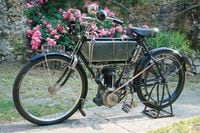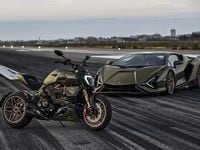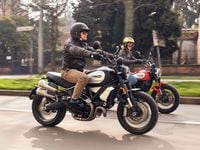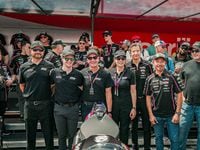Easy first pick is the New Werner, circa 1900, which was the combination of a De Dion engine (a zillion of these were quickly disseminated all over the world, becoming the basis of nearly everyone else’s engines) and a bicycle frame (bicycles were a synthesis of light steel tubing, roller chain, ball bearings and pneumatic tires, technologies that came together with a resounding crash in the mid-1890s, spawning a huge craze). What the two Russian brothers, Eugene and Michel Werner, did was to try the engine in every possible location and then settle on pretty much where engines are today. They also wouldn’t shut up and kept selling until people paid attention.
Cars were the action because they sold for high bucks. By 1910, Daimler would have 900 machine tools on the production floor, with 2000 people at work. Cars had multi-speed gearboxes, clutches, magnetos, overhead valves—everything long before they came to their poor relations: bikes. The car/bike price ratio was 40-to-1, so figure it out: If today’s four-door econobox is $18,000, divide that by 40 and think how many cylinders, cams and valves we’d get for $450. At that price, we’d be lucky if it ran.

/cloudfront-us-east-1.images.arcpublishing.com/octane/2PLTVHXY7FDSPFHKU5CFOC43ZY.jpg)
/cloudfront-us-east-1.images.arcpublishing.com/octane/B6M3WTRLFZGNXBEATNXPVGBBD4.jpg)
/cloudfront-us-east-1.images.arcpublishing.com/octane/4CMH3FI73BEM5D6MFYX42FLDSQ.jpg)
/cloudfront-us-east-1.images.arcpublishing.com/octane/RIHAPYNWU5H3XAOXNOPRWCBTQA.jpg)
/cloudfront-us-east-1.images.arcpublishing.com/octane/HU4NUBCL3VAFZA75VYRCMAUHVM.jpg)
/cloudfront-us-east-1.images.arcpublishing.com/octane/OB43AZK7TRA6XLZL5WRDVW2TDA.jpg)
/cloudfront-us-east-1.images.arcpublishing.com/octane/5G44Y3FXWNFSTEQKCA355PXOPU.jpg)

/cloudfront-us-east-1.images.arcpublishing.com/octane/XRI4GTLCVBA5NESASCBIR5LYQI.jpg)
/cloudfront-us-east-1.images.arcpublishing.com/octane/EF7566PXARGMBAOMLWTECYL3LE.jpg)





/cloudfront-us-east-1.images.arcpublishing.com/octane/3LASNXSWUZFFPISURDJF3OCWBU.jpg)
/cloudfront-us-east-1.images.arcpublishing.com/octane/2BHJKWUTBNBTLMQCKDNVEG6DKQ.jpg)
/cloudfront-us-east-1.images.arcpublishing.com/octane/MPHXIIV54NAU5L6E4SYZHCXVRM.jpg)



/cloudfront-us-east-1.images.arcpublishing.com/octane/WYXFHF4ZOBBTXELIZDB2FJXU64.jpg)
/cloudfront-us-east-1.images.arcpublishing.com/octane/K5FNV7ONUVDXJJ2H5BIWUGBGTI.jpg)
/cloudfront-us-east-1.images.arcpublishing.com/octane/MGVKP5VTNJHQ7FWNAHIWX4OHO4.jpg)